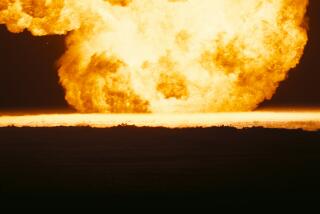Firm Provides Graphic Evidence
- Share via
To explain the cause of an explosion that shook Louisville, Ky., at the crack of dawn four years ago, the city’s lawyers turned to Robert Seltzer, a 39-year-old graphics designer in Los Angeles whose company, Graphic Evidence, specializes in visual presentations for the courtroom.
In three months and for $80,000, Graphic Evidence produced a 10-minute videotape that combined computer animation with conventional graphics and pictures to give a simple but clear account of what Louisville officials believe happened that morning: A poorly maintained vat at a Ralston Purina Co. plant accidently leaked a highly flammable fluid into the city’s sewage system, causing a blast that ruined extensive sections of the city’s streets.
The film’s visual explanation of the technical and complex workings of the vat’s plumbing--and the fluid’s chemistry--was so clear, Seltzer said, “that the judge thanked me for it.” The city’s lawyers thanked him too, saying it was no accident that Ralston Purina settled the suit out of court for $15.5 million the day after viewing the film.
“They didn’t want a jury to see it,” Seltzer said. “They might have understood what happened.”
An explosion, a real estate fraud or a plane crash are equal in the eyes of most juries and judges--equally confusing. The technicalities involved the daily events that land in court are increasingly difficult to convey by words alone. Many lawyers are turning to sophisticated visual aids for help. And judges, once reluctant to allow such aids as evidence, have warmed up to the idea over the last decade, opening the door for the several dozen companies like Seltzer’s that have sprung up nationwide to meet the growing demand.
Business is booming. Seltzer, for example, says that Graphic Evidence has grown from a one-man outfit to a 12-person, $600,000-a-year business since he founded it eight years ago. He says he expects sales to reach $1 million this year. Although most of his customers are local, many states are represented by his list of clients.
Seltzer points out that professionally prepared visual presentations for the courtroom are unlike professionally prepared corporate presentations, whose popularity also has grown over the last 10 years, Seltzer says. A corporate presentation can use any means, fictitious or real, to strike the desired response.
A courtroom presentation cannot. It must be “accurate and real” to maintain the reputation of the lawyer and the client. At the same time, it must distill “piles of data” into a simple set of facts or fashion an abstract idea into a concrete image that any jury or judge can understand.
Seltzer, like others, has used technical, artistic and legal expertise to nudge his company into a niche that caters to the slick design needs of the legal community. He is a former computer programmer who has fine art degrees from the Otis Art Institute in Los Angeles and one year of law school at Whittier College under his belt.
The use of visual aids in the courtroom has become so prevalent that many law firms in recent years have established in-house graphics departments. O’Melveny & Myers, for example, a Los Angeles-based firm that employs several hundred lawyers in five offices nationwide, created such a department 2 1/2 years ago.
But smaller law firms, coupled with the growing use of visual aids, ensure plenty of business for designers such as Seltzer. “Let’s face it, I can’t be on both sides of a case at once, can I?” he says. “If one side uses sophisticated computer graphics, the other side will--or should--be thinking about it, too.”
More to Read
Inside the business of entertainment
The Wide Shot brings you news, analysis and insights on everything from streaming wars to production — and what it all means for the future.
You may occasionally receive promotional content from the Los Angeles Times.










